
views
Researching Your Plans and Hiring a Team

Look at magazines and websites to find inspiration. Do some research to get a clear vision of what you want each room to look like. Spend some time browsing design magazines and websites. Tear out pictures of ideas that you like, or digitally save images that appeal to you. Try to figure out a theme early on and stick to it. For example, think about whether you want your kitchen to be modern, traditional, or eclectic. If you admire a friend’s home, ask them if they’d mind telling you where they shopped or found inspiration.
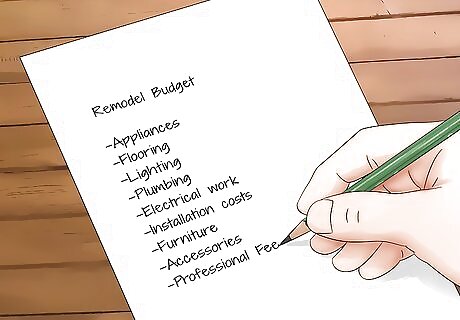
Figure out your budget. Home renovations can get very expensive quickly. To avoid the stress of overspending, create a detailed budget and stick to it as closely as possible. You can contact your bank about securing a home equity loan to cover the costs. Contact professionals and visit stores to get an idea of prices. You’ll want to estimate costs for items like: Appliances Flooring Lighting Plumbing Electrical work Installation costs Furniture Accessories Payment to any professionals you hire EXPERT TIP Ken Koster, MS Ken Koster, MS Master's Degree, Computer Science, Stanford University Ken Koster is the Co-founder and CTO of Ceevra, a medical technology company. He has over 15 years of experience programming and leading software teams at Silicon Valley companies. Ken holds a BS and MS in Computer Science from Stanford University. Ken Koster, MS Ken Koster, MS Master's Degree, Computer Science, Stanford University Plan to stay somewhere else, if you can. Ken Koster, a software engineer who recently renovated his home, says: "If you need to live in the house while you're remodeling it, you can do it room by room, but it's going to add a tremendous amount of time and cost to the project. If you're doing an extensive remodel, though, it's best to move out if you can, so you can do all the demolition and framing first, then the plumbing, electricity, and any necessary inspections. After that, you can move on to covering everything up."

Hire an architect if you are doing major structural changes. If your renovations are simple, you might be able to handle them yourself. But if you plan on knocking down walls, adding plumbing, creating new windows, or moving a staircase, to name a few changes, you’ll want to work with an architect. Contact several architects to find one that you want to work with. Before you hire an architect, make sure to ask to look at their portfolio. You want to make sure that they have experience handling projects similar to yours. You should also ask for a quote about how much their work will cost.

Work with an interior designer if you want help decorating. An interior designer can bring your ideas to life. Hiring a designer is a great idea if you want someone else to shop for things like furniture and accessories. Meet with a few designers to find one that you feel comfortable with. Take some time to look through each designer’s portfolio. Choose one who has created rooms that you like. Make sure to get a quote for how much each designer’s services will cost.
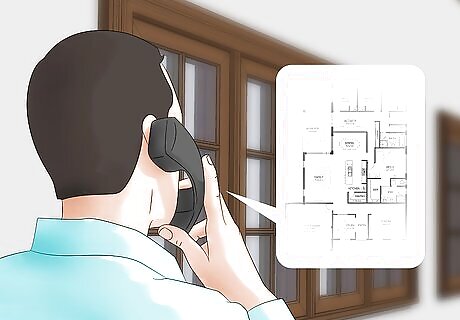
Find a contractor if you would like someone to manage the project. Look for a general contractor if you have a large or complex project. They will supervise all workers, get the necessary building permits, and oversee all elements of the remodel. If your project is smaller, consider a specialty contractor who works on installing items like countertops and bathroom fixtures. Whichever type of contractor you need, meet with a few candidates before hiring anyone. You should also ask for a projected budget and timeline. Ask family and friends for recommendations. You can also read online reviews to see if other customers had a positive experience. At a minimum your contractor should be licensed, have insurance, and have at least 5-10 years of experience.
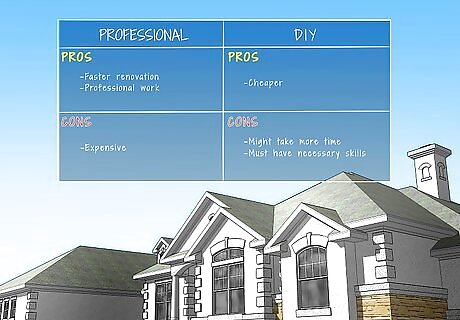
Weigh the pros and cons of a DIY renovation. Once you start pricing the services of professionals, you might be tempted to go the DIY route. Before you make that choice, consider several factors. For example, if you don’t have the necessary skills, you might end up doing costly damage. Also consider your timeline. It will likely take you much longer to do the job than a professional. Decide if that is a major factor in your decision. If you decide that you want to do the work yourself, make sure that you do so safely. Do not attempt to rewire your house, for instance, if you don’t have that sort of experience. However, you can paint the walls in your living room yourself without any prior experience. Don't be afraid to hire a professional only for the things you need. For example, you might hire someone to install your appliances, but choose to decorate on your own.

Make a timeline and plan to stay organized. Figure out a reasonable timeline. For example, it is unreasonable to expect a full kitchen renovation in a day. It's much more likely to take at least 2 weeks. Pick a target date, but be prepared for setbacks. For example, sometimes items you purchase might be on backorder. If you hire professionals, check in with them at least once a week to check on their progress. If you are doing the work yourself, resist the urge to multitask. If you start on the bedroom before the bathroom is done, you’ll end up with 2 projects, which is harder to manage than just 1 at a time.
Renovating a Kitchen
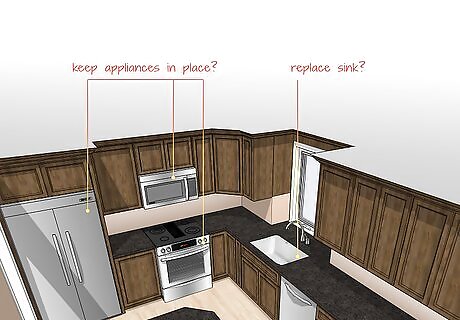
Keep your current layout for a cost-effective remodel. If you want a new kitchen, you might think it makes sense to do a complete overhaul. However, keeping your current layout can save you a significant amount of money. When possible, try to leave major fixtures and appliances where they are. For example, you might think it would be nice to have your sink on a different wall. But that would mean ripping out old plumbing and installing new pipes. Instead, ask yourself if you can live with just having a new sink installed in the old spot. Similarly, it can be very expensive to create new spaces for your range or wall oven.
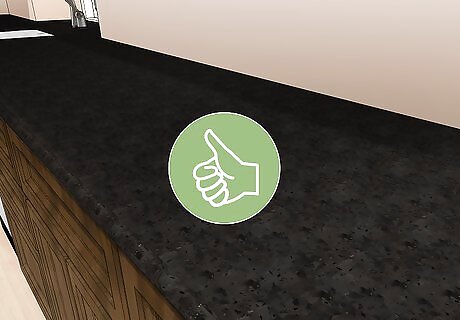
Choose granite countertops for the most popular choice. Keep the resale value of your home in mind as you make renovations. Many buyers prefer granite countertops, so if there is a chance you will sell or need home equity in the future, granite is the smart choice. You can choose from a variety of shades, from light to dark. Make sure to price several different cuts of granite. Oftentimes, a $25 slab will look just as good as one that costs $45. Choose laminate for a more affordable option. If you have an average-sized kitchen, you can expect to pay $500-$1200 to have laminate installed. Granite would cost about $3,000-$3500. Keep in mind that they typically don’t last as long as granite. Laminate likely won't last more than 10 years, while granite can last for over 100 years.
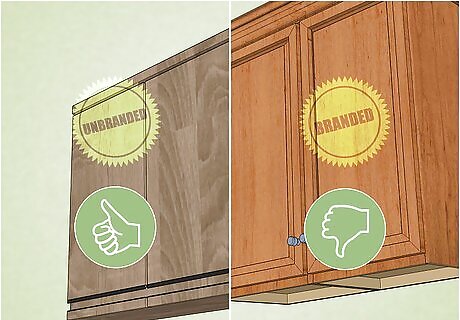
Select non-name brand cabinets to stay within your budget. Cabinets can quickly become one of the most expensive parts of a remodel. Name brand cabinets cost significantly more than mid-range cabinets but offer the same quality. What’s most important is that you choose a solid wood front for the doors and drawers. Laminate particleboard is cheaper, but won’t hold up well. You can expect to pay between $100-$300 per square foot for cabinets, depending on the materials you select. Make sure that the shelves are made of at least .5 inches (1.3 cm) thick furniture grade plywood. Talk to your supplier about getting a warranty for your cabinets. Many will offer one.

Look at a variety of appliances to find ones that fit your space and budget. Unless you are a serious chef, you probably don’t need top-of-the-line appliances. Instead, look for mid-range products that have excellent customer reviews and warranties. You can compare models online, but it might be most helpful to go to a store so that you can get a feel for what you want. Most importantly, make sure you have enough space for what you choose. Measure both your space and appliances carefully. You should look at a range of Refrigerators Ovens Cooktops Microwaves Dishwashers The features you choose are really up to you. If you want to increase resale value, go for energy-efficient appliances. These are typically quiet and cut down on electric bills.
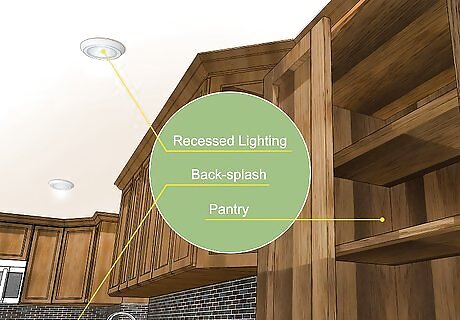
Add special features that will increase resale value. Most home buyers are looking for similar features. To make sure that you get the most money out of your remodel, consider adding some or all of the following features: Extra storage space, such as a pantry or lazy Susan Recessed lighting Tile back-splash Energy-efficient appliances
Updating a Bathroom

Identify the purpose of your remodel. Ask yourself several questions before you begin this renovation. For example, identify if you are updating to modernize the plumbing and fixtures or simply to make a style change. The former will be more expensive, so budget accordingly. Also, make sure to keep in mind what you need. While Jacuzzi tubs are popular, for instance, you don’t need one if you don’t enjoy a long soak. If you are working with a professional, ask them for advice on what sort of fixtures are most appropriate for your space. Take into account whether you want this room to stay in the same style as the rest of the house and plan accordingly. For example, if the rest of your house is ultra-modern, you probably don't want to choose a rustic look for your bathroom.
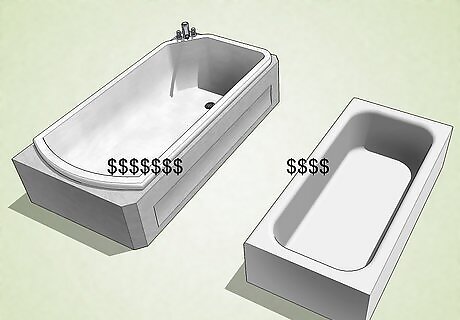
Choose between custom-built or more affordable store-bought accessories. If you want a luxurious bathroom that is your sanctuary, custom-built fixtures might be the way to go. That way, you can have the corner soaking tub and the standalone rain shower. But if you’re looking for function over style, consider getting store-bought fixtures, like a bathtub. They will be much more affordable. Visit a store that sells fixtures and spend some time deciding what you want to focus on. For example, if you want a free-standing tub to be the focal point of your room, allocate extra money for that feature.

Pick porcelain for a long-lasting tile. Natural stone tiles have become very popular for bathroom floors and shower walls. However, if you choose porcelain as your material, you can save a lot of money. Also, porcelain is incredibly long-lasting, so you’ll be getting the best value for your money. Many porcelain tiles are now made to mimic the look of natural stone, so you can have the best of both worlds!
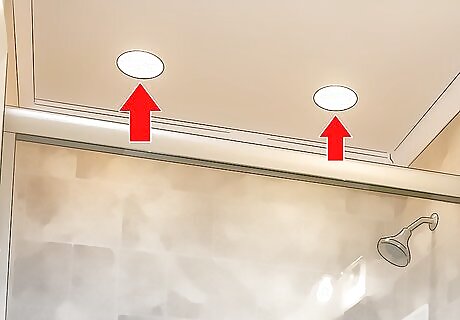
Install recessed lighting to brighten up the room. Bathrooms are often small, so it’s important that your lighting helps highlight the space you do have. Recessed lighting throughout the ceiling can help make the room seem brighter. Try to add 1 or 2 of these fixtures in the shower, as well. You might also want to consider some bright lighting around the mirror, which can make it easier to see any makeup you’re putting on. If you can, add a window to your bathroom. This feature adds a lot of resale value.

Choose a wall-hung toilet for an affordable space saver. Wall-mounted toilets are increasingly popular for good reason. They save a lot of space, as the tank is inside the wall. Also, the toilet is hung from the wall, leaving the floor underneath clear. This makes it a breeze to clean underneath! Keep in mind that while the toilets are relatively affordable, installation can be expensive. You might be able to DIY if you have any knowledge of plumbing.
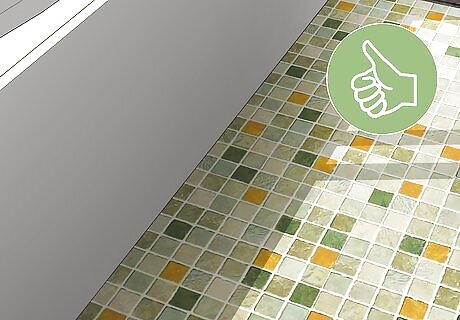
Use small tiles for a safer shower floor. Smaller tiles (about 1 inch (2.5 cm) will give you more traction. Choose smaller tiles to make your shower floor more slip-proof. You can choose tiles similar to those on your bathroom floor to create a cohesive look.

Maximize space by creating several storage spaces. Because bathrooms can be small, storage space is often limited. When planning your renovation, make sure to include several separate storage areas. For example, you might include a linen closet for storing extra towels. Large medicine cabinets and under sink storage are also great ways to add storage space. Consider adding a ledge in your shower where you can store products like shampoo.
Redoing a Living Space and Bedrooms
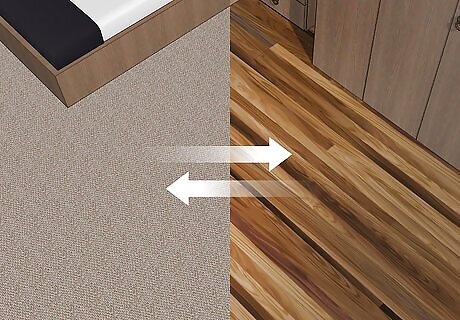
Select new flooring to update the space. The floor is the part of the room that is most likely to show wear and tear. One of the best ways to refresh a room is to install new flooring. If you’ve had carpet before, consider changing to hardwood or laminate floors. If you choose carpet, make sure it reflects your lifestyle. For example, white carpet probably isn’t a wise choice if you have small children or a playful puppy. Visit a flooring store to look at samples and get a feel for what materials cost. For example, laminate is less expensive than actual hardwood. You could compare the 2 to see what works for you.

Paint the walls to make the room feel new. Painting is probably the easiest way to give a room new life. For a bedroom, try to stick with cool tones such as blue. This will create a soothing environment. Feel free to be creative in your living space. For example, you could have a gray room with 1 red wall to create a dramatic accent.
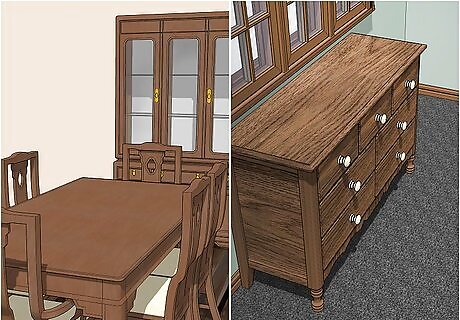
Purchase new furniture to modernize the room. Whether you’re looking for a new dining table or an updated sofa, furniture will help make your newly redone room feel like home. Spend time browsing design magazines to get a sense of what you like. If you’re working with a designer, provide them with plenty of clippings before they shop. For the kitchen, look at tables, storage racks, and bar stools. You might price couches, end tables, and lamps for your living room. For the bedroom, consider headboards, dressers, and nightstands. You might want a new table or buffet for the dining room. Your furniture should fit your lifestyle. For example, if you have a large family, consider a long dining table with a bench on 1 side to accommodate several people. If you and your partner love movie night, a comfy sofa might be your priority.

Accessorize the room for an easy update. If you don’t have the budget for a complete remodel, add accessories to any room for an easy update. In the living room, add new picture frames, lamps, and area rugs. You could add a new end table to your bedroom. For your dining room, you might display decorative plates on the walls. To jazz up your table, add new placemats and napkins. Mirrors are a great way to make a small room look larger. To fill a large room, consider purchasing some oversize pieces, such as a long table or sectional sofa.

Redesign the lighting to add mood and ambiance. Harsh overhead lights can make a room feel less homey. Try adding several tables and floor lamps to a room to make it feel more welcoming. You can also add a chandelier or pendant to give your room an interesting new focal point.




















Comments
0 comment